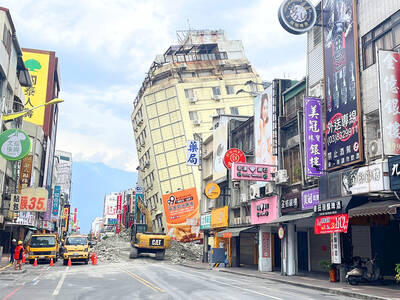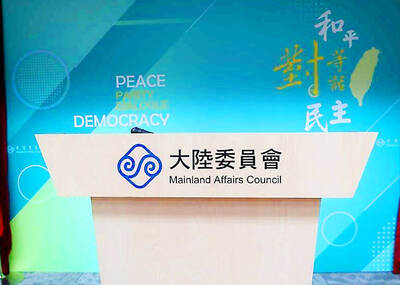A massive missile and drone attack destroyed one of Ukraine’s largest power plants and damaged others, Ukrainian officials said on Thursday, part of a renewed Russian campaign targeting energy infrastructure.
The Trypilska plant, which was the biggest energy supplier for the Kyiv, Cherkasy and Zhytomyr regions, was struck numerous times, destroying the transformer, turbines and generators, and leaving the plant ablaze.
As the first drone approached, workers hid in a shelter, saving their lives, said Andrii Gota, chairman of the supervisory board of the state company that runs the plant, Centrenergo.

Photo: Reuters
They watched the plant burn, surrounded by dense smoke and engulfed in flames.
“It’s terrifying,” Gota said.
Hours later, rescuers were still dismantling the rubble.
In Moscow, Russian President Vladimir Putin cast the attacks on Ukrainian energy facilities as a response to Ukrainian strikes that targeted Russian oil refineries.
The Trypilska plant supplied electricity to 3 million customers — but none lost power because the grid was able to compensate since demands are low at this time of year. Still, the consequences of the strikes could be felt in the coming months, as air-conditioning use ramps up in summer.
At least 10 other strikes overnight damaged energy infrastructure in Kharkiv. Ukrainian Minister of Foreign Affairs Dmytro Kuleba said more than 200,000 people in the region, which has been struck repeatedly, were without power.
Ukraine’s largest private energy operator, DTEK, described the slew of strikes as one of the most powerful attacks this year, while Ukrainian Minister of Energy Herman Halushchenko told reporters it was a “large scale, enormous, missile attack that affected our energy sector very badly.”
Russia’s renewed attacks on Ukrainian energy facilities last month blacked out large parts of the country — a level of darkness not seen since the first days of the full-scale invasion in 2022.
The volume and accuracy of the attacks have alarmed Ukrainians and left officials scrambling for better ways to protect energy assets. The strikes have also tested Ukraine’s ability to make quick repairs.
Kyiv’s leaders have pleaded for more air defense systems to ward off such attacks, but those supplies have been slow in coming.
“Today’s situation demonstrates that there’s nothing left to shoot down” the missiles, Gota said.

LANDSLIDES POSSIBLE: The agency advised the public to avoid visiting mountainous regions due to more expected aftershocks and rainfall from a series of weather fronts A series of earthquakes over the past few days were likely aftershocks of the April 3 earthquake in Hualien County, with further aftershocks to be expected for up to a year, the Central Weather Administration (CWA) said yesterday. Based on the nation’s experience after the quake on Sept. 21, 1999, more aftershocks are possible over the next six months to a year, the agency said. A total of 103 earthquakes of magnitude 4 on the local magnitude scale or higher hit Hualien County from 5:08pm on Monday to 10:27am yesterday, with 27 of them exceeding magnitude 5. They included two, of magnitude

A total of 41 US military personnel were stationed in Taiwan as of December last year, a US congressional report said on Friday last week ahead of Tuesday’s passage of an aid package that included US$8 billion for Taiwan. The Congressional Research Service in a report titled Taiwan Defense Issues for Congress said that according to the US Department of Defense’s Defense Manpower Data Center, 41 US military personnel were assigned for duty in Taiwan. Although the normalization of relations with the People’s Republic of China (PRC) in 1979 included a vow to withdraw a military presence from Taiwan, “observers have indicated

Taiwan Semiconductor Manufacturing Co (TSMC, 台積電) on Wednesday said that a new chip manufacturing technology called “A16” is to enter production in the second half of 2026, setting up a showdown with longtime rival Intel over who can make the fastest chips. TSMC, the world’s biggest contract manufacturer of advanced computing chips and a key supplier to Nvidia and Apple, announced the news at a conference in Santa Clara, California, where TSMC executives said that makers of artificial intelligence (AI) chips will likely be the first adopters of the technology rather than a smartphone maker. Analysts said that the technologies announced on

NO RECIPROCITY: Taipei has called for cross-strait group travel to resume fully, but Beijing is only allowing people from its Fujian Province to travel to Matsu, the MAC said The Mainland Affairs Council (MAC) yesterday criticized an announcement by the Chinese Ministry of Culture and Tourism that it would lift a travel ban to Taiwan only for residents of China’s Fujian Province, saying that the policy does not meet the principles of reciprocity and openness. Chinese Deputy Minister of Culture and Tourism Rao Quan (饒權) yesterday morning told a delegation of Chinese Nationalist Party (KMT) lawmakers in a meeting in Beijing that the ministry would first allow Fujian residents to visit Lienchiang County (Matsu), adding that they would be able to travel to Taiwan proper directly once express ferry